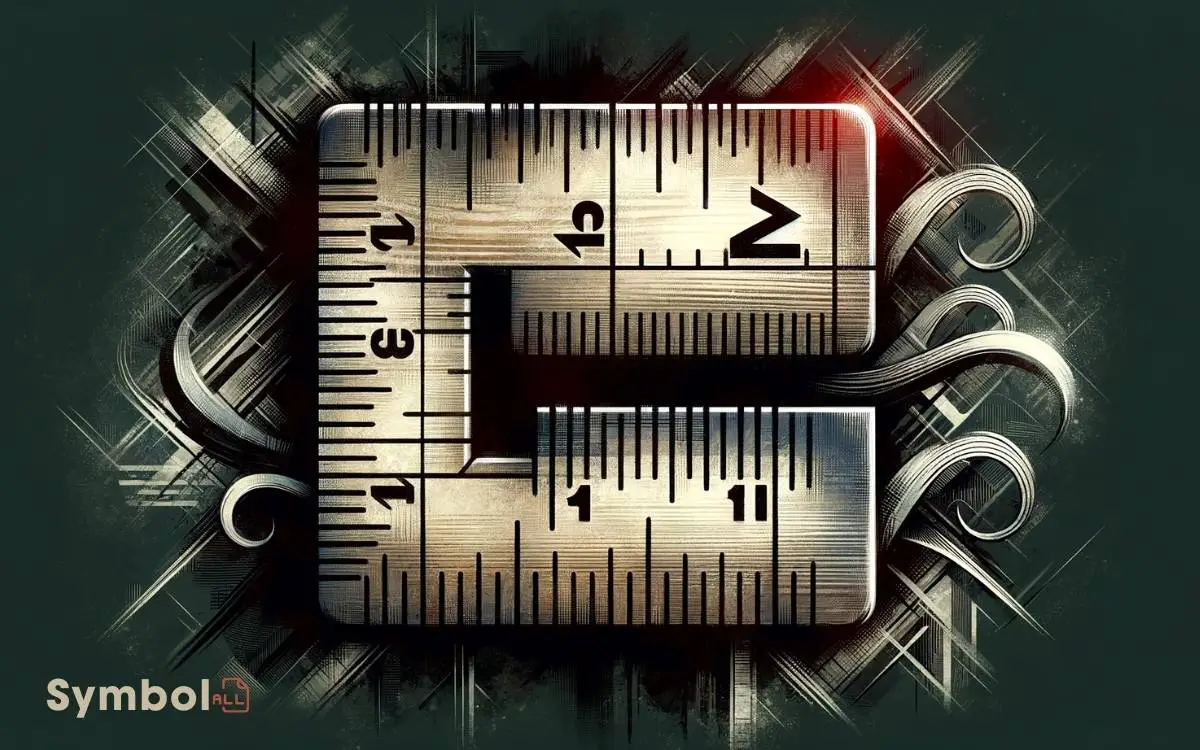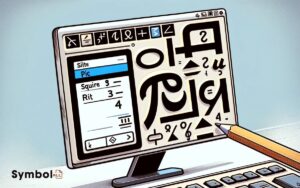What Symbol Is Used for Inches? Double Prime (″)!
The symbol you’re looking for is the double prime (″). It’s universally recognized for denoting inches, crucial in ensuring precision across various measurements and contexts.
Whether you’re involved in engineering, construction, or retail, mastering this symbol is key to accurate designs, blueprints, and product specifications.
While certain countries have variations like ‘in’ in the UK or ‘po’ in Canada, the double prime symbol remains the standard, especially in digital formats. Adhering to this convention maximizes understanding and prevents errors.
Grasping its significance extends beyond simple notation; it leads to insights into measurement history and global practices.

Key Takeaways
Definition of an Inch
An inch, often symbolized by the double prime mark (‘), measures exactly 2.54 centimeters and serves as a standard unit of length in the United States customary and British imperial systems.
You’ll find it commonly used in various contexts, from measuring the dimensions of a room to the size of your screen.
Understanding its precise measurement and symbol is crucial, especially if you’re involved in fields that require exact specifications, such as engineering, construction, or design.
Remember, when you’re dealing with measurements, precision is key. This means always double-checking your numbers and being aware of the unit conversions.
Knowing that an inch translates to 2.54 centimeters allows you to communicate dimensions accurately, ensuring that your projects or purchases meet your exact needs.
Historical Symbol Origins
Having explored the definition and significance of an inch, let’s now uncover the roots of its symbolic representation.
The inch has been an essential unit of measurement for centuries, and its symbol has evolved over time. Understanding its origins gives us insight into its importance in measurement history.
- Ancient Roots: The term ‘inch’ originally comes from the Latin word ‘uncia,’ meaning ‘one-twelfth part.’ This was a reference to one-twelfth of a Roman foot.
- Medieval Adaptations: In medieval times, the inch was symbolized by various marks, often derived from the first letter of ‘uncia.’ This practice linked measurement directly to its linguistic roots.
- Standardization Efforts: As measurement systems modernized, the need for a standardized symbol grew. This led to the adoption of a more universally recognized notation for inches, aligning with broader efforts to unify measurement systems worldwide.
Current Symbol for Inches
Today, the symbol for inches is universally recognized as a double prime (″), reflecting its precise measurement standard. This symbol isn’t just a random choice but a carefully selected representation that ensures clarity and universal understanding across various fields.
Whether you’re drafting architectural plans, designing a piece of furniture, or specifying dimensions for a tech gadget, the double prime symbol is your go-to notation for indicating inches.
It’s concise, clear, and avoids confusion with other units of measurement. You’ll find it consistently used in technical documents, textbooks, and product specifications.
It’s essential to familiarize yourself with this symbol, as it’s the key to accurately communicating measurements in inches. Remember, whenever you see the double prime symbol, you’re dealing with a measurement in inches.
Variations Across Countries
Despite the widespread adoption of the double prime symbol for inches, you’ll often encounter variations in its use across different countries.
Understanding these differences is crucial for accurate communication and documentation in international projects.
Here are three key examples:
- United Kingdom: While the double prime symbol is standard, older documents might use the abbreviation ‘in’ without a period, reflecting historical practices.
- Canada: Bilingual documentation may use both the double prime symbol and the French abbreviation ‘po’ (for ‘pouce’), depending on the context and audience.
- Japan: Although the double prime symbol is recognized, Japan frequently uses the metric system. When inches are referenced, they might alternatively use the kanji character for ‘inch’ (寸) in technical or traditional contexts.
These variations highlight the importance of understanding local practices in international measurements.
Usage in Digital Formats
In digital formats, you’ll often see the double prime symbol used to denote inches, adapting to various software and platform requirements. This symbol, resembling two small ticks or quotes (″), is the standard in digital documentation, design software, and specifications.
When you’re entering measurements in a text editor or a design tool, using the double prime ensures clarity and uniformity, regardless of the platform. It’s crucial, especially in fields requiring precise measurements like engineering, architecture, or graphic design.
Also, in programming and web development, adhering to this standard prevents misunderstandings in specifications. Remember, digital formats demand consistency for effective communication.
By using the double prime symbol, you’re aligning with global practices, facilitating clearer understanding and reducing errors in digital projects.
Common Misinterpretations
When you encounter the symbol for inches, it’s easy to mistake the prime symbol for something it’s not, leading to confusion.
Mixing up measurements between the metric system and the imperial system is another common error you might make.
Prime Symbol Confusion
Many people mistakenly interpret the prime symbol (′) as an apostrophe or a quotation mark rather than the correct indication for inches. This confusion can lead to misunderstandings in measurements and documentation.
To prevent misinterpretation, consider these key points:
- Distinct Appearance: The prime symbol is vertical and lacks the curvature of an apostrophe or the opening/closing forms of quotation marks.
- Contextual Clues: In measurements, a prime symbol follows a numeric value, a clear indicator of its role in denoting inches.
- Standard Usage: Official documents and technical fields consistently use the prime symbol for inches, distinguishing it from punctuation marks.
Understanding these distinctions ensures accurate communication and prevents errors in interpreting measurements.
Metric System Mix-Up
Confusion often arises when individuals mistakenly interchange metric measurements with imperial units, leading to significant discrepancies in understanding.
You may find it easy to confuse the two, as both systems are widely used across different regions. However, recognizing their distinct symbols and units is crucial for accurate communication and documentation.
The inch, represented by a double prime symbol (″), belongs to the imperial system, which contrasts with the metric system’s use of centimeters (cm) and meters (m) for length measurements.
Misinterpreting these can result in errors in dimensions, scale, and property estimations.
It’s essential to double-check which system is being used in your documentation or communication to ensure precision. Avoiding this common mix-up helps maintain clarity and prevents unnecessary complications in various professional and personal contexts.
Typography Versus Handwriting
Understanding the symbol for inches is just the start; now let’s explore how typography and handwriting can lead to common misinterpretations. When you’re jotting down measurements or reading them, clarity is key.
However, the distinction between typography and handwriting can blur lines, causing confusion.
- Consistency: Typography offers uniform symbols, while handwriting varies greatly, sometimes making the inch symbol (“) look like a prime symbol (′) or vice versa.
- Legibility: In handwriting, the inch symbol can be mistaken for a quotation mark, especially if it’s not clearly differentiated.
- Spacing: Typed symbols have fixed spacing. In handwriting, if the space between the number and the inch symbol is too wide, it mightn’t be recognized as a unit of measurement.
Symbol in Professional Contexts
In professional settings, the symbol for inches, represented as a double prime (″), is crucial for accurate measurements and documentation. You’ll find this symbol across various fields, ensuring clarity in communication and preventing errors in measurement interpretation. In industries like engineering, construction, and design, using the correct symbol, such as the double prime (″) for inches, ensures precision and standardization. Misinterpreting measurements can lead to costly mistakes, so attention to detail is paramount. Interestingly, just as the double prime holds significance in measurement, the phrase ‘Ed Sheeran math symbols meaning‘ highlights how symbols can carry deeper interpretations, as seen in creative fields like music and album artistry.
Here’s a brief overview of its importance:
| Field | Use of Symbol | Impact |
|---|---|---|
| Engineering | Design specs | Precision in manufacturing |
| Construction | Blueprint | Accurate building structures |
| Retail | Product sizes | Correct product selection |
Understanding its application ensures you’re interpreting measurements as intended, whether you’re drafting a blueprint, designing a new gadget, or specifying product dimensions.
The double prime symbol is more than a typographical choice; it’s a standard that professionals rely on for precision and clarity in their work.
Tips for Remembering
Now that we’ve explored the importance of the inch symbol in various professional settings, let’s look at some effective strategies to help you remember how to use it correctly.
Here are three tips:
- Associate with Visuals: Link the inch symbol (‘) to common items. Imagine it next to objects around you, like a 12′ ruler or a 3’ phone screen.
- Practice Regularly: Use it in your day-to-day measurements. Whether you’re measuring furniture or noting dimensions for a project, practice writing it down.
- Create Mnemonics: Develop a memorable phrase or story that includes the symbol. For example, ‘Inches ‘inch’ their way on paper with two little marks.’
Conclusion
In wrapping up, remember that the symbol for inches, the double prime (″), isn’t just a quirky mark. It’s steeped in history and universally recognized.
Interestingly, an estimated 95% of people still mix up the inch (″) and foot (′) symbols when jotting down measurements. So, next time you’re noting dimensions, think of this fun fact and double-check you’re using the right symbol.
With this knowledge, you’ll communicate measurements like a pro, ensuring precision and avoiding any mix-ups.





